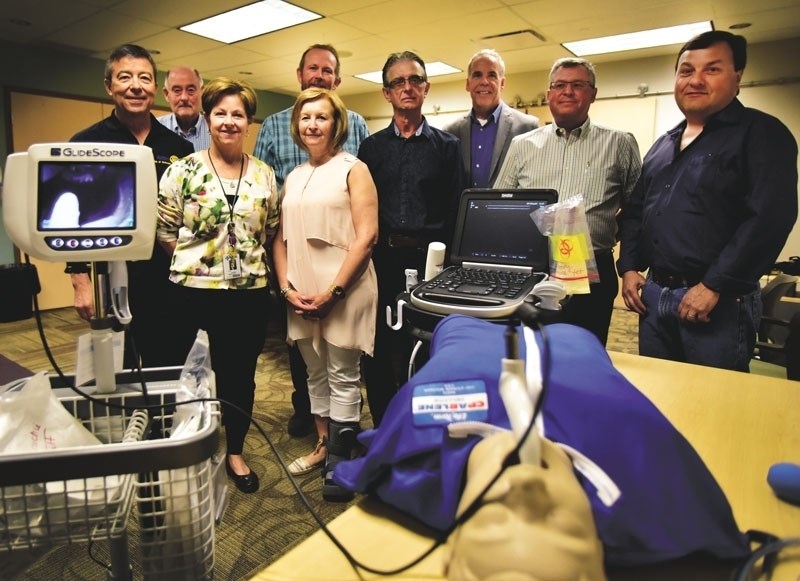The Cochrane Urgent Care Centre is now Alberta's first to receive a diagnostic ultrasound imaging system and a GlideScope Video Laryngoscope.
The Cochrane Urgent Care Centre is now Alberta's first to receive a diagnostic ultrasound imaging system and a GlideScope Video Laryngoscope.
Thanks to a generous donation from the Cochrane Rotary Club and the Lindsay Leigh Kimmett Memorial Foundation, the centre can now better perform critical procedures needed to stabilize emergency patients.
According to Dr. Glenn Curtis, the medical director for the centre, Cochrane is the first in the province to receive this equipment and the GlideScope. Airdrie's urgent care centre will be also receiving ultrasound equipment.
The Cochrane Rotary Club initially had its first conversations with Alberta Health Services and Calgary Health Trust in August 2013 to discuss the type of donation that the Cochrane health care community needed. The Lindsay Leigh Kimmett Memorial Foundation soon joined in on the discussions and in January 2014 it was determined the need for ultrasound technology in Cochrane was the most imperative.
Initially, the partners wanted to raise $140,000 to start an ultrasound outpatient clinic within Cochrane. Through its annual Monumental Tournament of Aces, the foundation managed to raise $98,000 to put toward the endeavour.
The Cochrane Rotary Club contributed another $40,000 to the project through fundraising of its own. In October 2014, the project ran into some complications.
“The price of oil went down just about a week after we raised the money. So their was indication from the Calgary Health Trust asking us to consider redirecting the money somewhere else because it didn't look like we'd get approval for the outpatient clinic, ” said Paul Kennedy with the Cochrane Rotary Club.
To further complicate the matter, Kennedy said the partners were told the Alberta College of Physicians and Surgeons wouldn't support their project.
“It just got to the point where the outpatient clinic wasn't going to happen or we couldn't even be given a date of when it might happen … it just seemed to us that we wouldn't be able to do anything with the money in an outpatient format and that's when we started talking with Cochrane Urgent Care, ” said Kelly Kimmett with the foundation.
Redirecting the ultrasound equipment to the Cochrane Urgent Care Centre was a happy alternative for the project. Kennedy said the donation used about half of the funds previously raised and the partners will soon be announcing who else will be receiving a donation from the project.
Curtis said that emergency departments have had this equipment for years but they are funded at a different level than urgent care centres so the donation is significant for the community.
“We can do a variety of different scans for different reasons with the ultrasound equipment, ” explained Dr. Glenn Curtis, the medical director for the centre.
He elaborated the equipment would allow for the location of veins in order to insert IVs, the identification of complications during pregnancy, the diagnosis of a splitting or enlarged aorta for patients with abdominal pain, and the identification of internal bleeding for patients with abdominal trauma.
“The GlideScope is a very specialized piece of equipment to assist in getting a breathing tube into somebody if we need to. If we have somebody coming in with respiratory failure - one of the most critical procedures that we do in urgent care is to get a breathing tube into somebody - it can be a lifesaving event, ” Curtis said.
He explained the GlideScope is essentially a video camera that is inserted partway down a person's throat, which allows them to see the vocal chords and where they must insert the breathing tube.
“We've had to do quite a bit of training. All the doctors have done quite an extensive course to get proficient with the ultrasound machine. And we all did a big training session on the GlideScope, ” Curtis said.
While the Cochrane Urgent Care Centre cannot compare to the services offered by a hospital, this new equipment is a step in the right direction to increasing care.
“We are still a rural site and for serious problems we will still end up transferring people to the Foothills Hospital in Calgary but it allows us to do a better job of the assessment and some of those critical procedures that we need to do to immediately stabilize somebody who's in trouble, ” Curtis said.
“My expectation and hope is that in critical situations, I'm optimistic and think that there's a good chance that this equipment will actually save lives by allowing us to do a better job. ”
